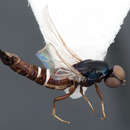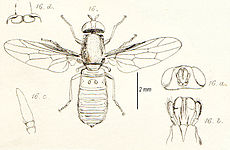en
names in breadcrumbs


Very little is known of the biology of this interesting family. A few of the well known, widely distributed species, such as Scenopinus fenestralis and S. glabrifrons, have well documented life histories and have been associated with their hosts. From the meager records that are available, it is clear that the larvae of the Scenopinidae are all predacious on other insects. A number of species are predacious on the larvae of dermestids and have been commonly collected at the windows of storehouses, feed mills, and museums. Members of the genus Pseudatrichia have been reared from the nests of wood rats, where they were feeding on the larvae of fleas and lice. Several species have been taken as larvae or pupae from the nests of birds and reared out. Members of the genus Belosta from the western United States have been associated with bark-infesting beetles attacking pines and hardwood, and one species has been taken from a termite nest. The members of the genus Prepseudatrichia from Africa have all been reared from larvae collected in the wood of Acacia and Sterculia attacked by buprestid larvae.
Information concerning the habitat of the larvae or the hosts on which they feed has been recorded for less than ten percent of the known species of Scenopinidae. From the meager records at hand, however, some important clues to possible areas of concentration are indicated. Among the more obvious localities are: where dermestids occur, such as grain storages, warehouses and museums; birds' nests, particularly those occupied for relatively long periods of time; the nests or dens of animals; scar wood or under bark attacked by wood boring larvae; and the nests of termites.
The larvae are elongate, light bodied, hard, smooth, and wormlike with an elongate, pointed, strongly sclerotized, yellow head. When these larvae are found they should be maintained with the host culture, which should be held for a month or two after the emergence of the host adult, as the Scenopinid adults do not emerge until the next generation of the host has begun development. The pupae of the Scenopinidae appear very spiny, particularly along the abdominal segments.
The scarcity of specimens in most collections appears to be the result of failure to collect in the right place at the proper time. Most of the specimens observed have been obtained by sweeping foliage or flowers which strictly limits the chances of contact. The adult period appears to be relatively short in most cases and occurs at a regular time each year. There is good evidence that in areas with uniform plant or animal associations, large numbers of adults are present at the same time. In one instance, in California, over 150 specimens of a single species were taken on a two-day period along a distance of more than 100 miles. Other extensive series have also been seen that were taken in a short period by field crop inspectors sweeping the same crop over an extensive area. In other instances, members of the same species have been taken at the same locality in successive years on about the same date. The use of some permanent type of trap such as a Malaise trap would probably result in better sampling than that accomplished by most collectors with hand nets.
The study of scenopinid evolution and biodiversity is an important part of the Diptera research programs of Steve Gaimari and Shaun Winterton, who both work on Asiloidea and 'Therevoid'-clade systematics...
The Scenopinidae or window flies are a small (about 400 described species)[1] family of flies (Diptera), distributed worldwide. In buildings, they are often taken at windows, hence the common name window flies.
The two species with cosmopolitan distributions are associated with the movement of trade goods (Scenopinus fenestralis and S. glabrifrons). Very little is known of the larval biology; larvae have been found associated with stored-grain pests, in nests of birds and rodents, in beetle larvae burrows in trees and shrubs, and in association with therevid larvae in soil. They may be predators of the larvae of other insects. Adults have sponging mouthparts and are found on open flowers.
The adults are small insects, usually with the body no longer than 5 mm, glabrous or slightly hairy and with blackish livery. The head is holoptic in the males of most species, and dichoptic in females. It is provided with three ocelli. The pendulous antennae are composed of three segments the two basal segments short and the third elongated; ‘modified’; with a nonannulated flagellum. The mouthparts are of the sucking type with the labrum (proboscis) very short and with a fleshy apex, and one- or two-segmented maxillary palps. The thorax is moderately convex, with mesoscutal bristles in the Proratinae. The legs are short and lack arolia and empodia. The wings overlap on the abdomen, in the resting phase. The abdomen is large and cylindrical or flattened, composed of seven apparent urites in males and eight in females.
The wing venation differs substantially from that of Therevidae by the number of branches of the media which are reduced to two or three and from that of Bombyliidae in having a simpler radial system. In most of the family, the costa stops short of the wing apex, in correspondence with the termination of R 5 or M 1. An exception is Caenotus, in which the costa extends for the entire margin.
The radius is divided into four branches, with R 2+3 undivided. The entire radial system is positioned in the front half of the wing, without going beyond the axis that connects the base with the apex. R 1 and R 2+3 are relatively short and converge on the costal margin with a short distance between them. R 4 terminates on the costal margin, R 5 terminates before the apex of the wing or, in some genera, at the apex (but R 5 may also converge on the apex as in Cyrtosarthe and Pseudatrichia).
The media is divided into two or three branches. M 1 is always present and usually reaches the wing margin before or at the apex of the wing (e.g. Scenopinus, Prepseudatrichia, Caenotinae, Proratinae); in most genera of Scenopininae, R 5 closes a cell, while in Cyrtosarthe, it converges on the posterior margin; in some Australian species, belonging to the genera Scenopinus and Rekiella, M 1 is incomplete and does not reach the margin. M 2 is missing in the majority of the Scenopininae, but it is present in the Proratinae in Cyrtosarthe and Caenotus and runs into on the posterior border.
In these genera, the bifurcation of M 1+2 coincides with the front apex of the distal discal cell, or is placed in a distal position with respect to the cell. M 3 is absent in the whole family, M 4 is always present, but in Seguyia it is incomplete and does not reach the margin.
The conformation of the cells is strictly dependent on the morphology of the venation: the marginal cell is very narrow and opens as does the submarginal on the costal margin; the first rear cell is relatively long and opens close to the apex of the wing. The discal cell has a pentagonal shape (quadrangular in the Scenopininae) apparently due to the absence of vein M 2 and the first basal cell is generally much longer than the second due to the development in length of the discal and the position of the radio-medial vein .
Diagram of wing veins in Scenopinus
Diagram of wing veins in Pseudatrichia or Metatrichia
In general, the larvae of the Scenopinidae colonize the sandy soils of arid environments or dry litter and feed by preying on other soil arthropods. Frequently, however, they are, always as predators, in other habitats, such as wood and other substrates, decomposing organic, dens and nests of mammals and birds, and sometimes domestic environments. The latter habit, derived from a secondary synanthropic adaptation, is frequent in some species of the genus Scenopinus. In this case, the larvae prey on insect pests of clothing (moths), foodstuffs (larvae of moths and beetles), wood (termites) or zooparasites associated with humans or domestic animals, such as dust mites and fleas. Adults feed on nectar and honeydew .
In the past, the Scenopinidae included only the current subfamily Scenopininae, while the other genera known at that time were placed in other families. Prorates was described and classified by Melander (1906)[2] among Empididae and Caenotus was described and classified by Cole (1923)[3] within Therevidae. Currently Prorates and other members of the former Bombyliidae subfamily Proratinae, as well as Caenotus, are included in Scenopinidae, sharing apomorphies with other Scenopinidae, resulting in three subfamilies: the Caenotinae, the Proratinae, and the Scenopininae.[4]
? Scenopinidae and Therevidae
? Mydidae and Apioceridae
? Asilidae
Clade showing relationship of Asiloidea
The oldest known member of the family is Burmaprorates alagracilis from the mid Cretaceous Burmese amber of Myanmar, which belongs to the subfamily Proratinae.[5]
The family is worldwide, and while the Nearctic realm has the most species, this may be because other parts of the world are far less intensively studied and many new species remain undiscovered.
The Scenopinidae or window flies are a small (about 400 described species) family of flies (Diptera), distributed worldwide. In buildings, they are often taken at windows, hence the common name window flies.
The two species with cosmopolitan distributions are associated with the movement of trade goods (Scenopinus fenestralis and S. glabrifrons). Very little is known of the larval biology; larvae have been found associated with stored-grain pests, in nests of birds and rodents, in beetle larvae burrows in trees and shrubs, and in association with therevid larvae in soil. They may be predators of the larvae of other insects. Adults have sponging mouthparts and are found on open flowers.
 Scenopinus fenestralis whole insect and dissected parts
Scenopinus fenestralis whole insect and dissected parts